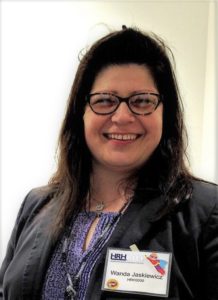
12 Nov Elated About e-Learning: A Critical Tool for Advancing UHC
 HRH2030 Project Director Wanda Jaskiewicz has more than 20 years of experience in international health and development with a focus on human resources for health, HIV/AIDS, family planning, reproductive health, and maternal and child health. She has worked in more than 25 countries providing strategic leadership to advocate for global and national initiatives to strengthen the health workforce.
HRH2030 Project Director Wanda Jaskiewicz has more than 20 years of experience in international health and development with a focus on human resources for health, HIV/AIDS, family planning, reproductive health, and maternal and child health. She has worked in more than 25 countries providing strategic leadership to advocate for global and national initiatives to strengthen the health workforce.
Without the health workforce, there will be no universal health coverage (UHC). And UHC requires a health workforce that is well-trained, well-supervised, and well-resourced. That’s why I was so honored to be in Manila a few weeks ago, when the Philippine Department of Health (DOH)—making a commitment to invest in health worker training—launched the DOH Academy e-Learning platform, developed in partnership with USAID Philippines and the HRH2030 program.
Continued professional development is vital for health workers. They need to keep up to date with the latest research and technologies, emerging health issues, and new treatment programs, along with updated licensing requirements for their service delivery areas. Of course, training human resources requires resources of other kinds—mainly financial investments and investments in time. And as the global health community pushes for acceleration toward UHC, e-Learning is the best bet for maximizing investments in training.
The DOH Academy went live on October 25, and included a video greeting from Secretary of the Department of Health Francisco Duque III, who noted that “The DOH e-Learning platform allows health workers to access learning modules anytime and anywhere. This will save travel time and enable trainers and health workers to spend more time attending to their patients.”
Indeed, this new platform is not only better for health workers, it’s better for patients. In-person professional development often requires health workers to spend days away from their facilities, both to travel to where the training is offered and to attend the course. When health workers can learn online, they don’t have to leave their posts to attend training, which means that patients are more likely to see their doctors, nurses, or other care providers and get the care they need, right when they need it—an important aspect of patient-centered care.
Health Undersecretary Mario Villaverde and USAID Acting Deputy Mission Director Thomas Bayer also attended the launch ceremony. Undersecretary Villaverde noted that the DOH Academy—the first of its kind in the Philippines—marked a new era of learning. Acting Deputy Mission Director Bayer emphasized the effort made to include all health workers, remarking, “Even in areas with no internet access, they will be able to access offline modules.” Listening to them, I heard the pride in their voices as they talked about the potential of this learning platform—not only for the benefit of health workers, but also for the health of the Filipino people.
Taking part in this event drove home for me the fact that increasing numbers of health workers worldwide are relying on e-Learning. Of course, this isn’t news—our HRH2030 program partners, the American International Health Alliance (AIHA) and Amref Health Africa have been training health professionals via online learning platforms and apps for years. The same week that I was in the Philippines, I read that nursing and midwifery students in Accra won Jhpiego’s Innovations Hackathon with a pitch that focused on e-Learning as the way to bridge the gap between theory and practice. And of course, USAID’s Bureau of Global Health launched the Global Health e-Learning (GHEL) Center in 2005, which includes a course on HRH Principles and Practices.
What is new—or perhaps I should say renewed—about e-Learning, is the commitment that many countries are making to scaling up this and other digital health innovations to advance health outcomes. e-Learning and mHealth are realizing the potential to have more accessible, affordable, accountable, and reliable health systems. Our HRH2030 team is proud to support the Philippines and other countries in these efforts.
___
Photo: Health Undersecretary Mario Villaverde (center left) and USAID Philippines Acting Deputy Mission Director Thomas Bayer (center right) apply their hand prints on a tablet to officially launch the DOH Academy at the October 25, 2019 ceremony in Manila. Credit: Alan Blue Motus, 2019.





